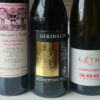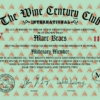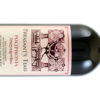Spain 2006 – part 1, Catalonia, Catalonia, what make your big wines so hot!
I arrived in Barcelona for the first of what I hope will be many trips to the wine regions of Spain on the afternoon of March 9th. An Importer who I work with, André Tamers and his company De Maison Selections organized the trip.
This is an ITB disclaimer- we only visited wineries represented De Maison – this is not to promote his wines but simply to share my experience on this trip.
After gathering all of the troops together it was off to our private bus – very swank. The bus had room for 14 though we were only 10 so there was a bit of room to spread out. Our driver, Jose Miguel was quickly dubbed “Ice” due to the shape of his hairstyle (which oddly resembled the shape of our bus) and the meticulous grooming of his eyebrows.
In minutes we were off to our first destination, Penedès – Cava country!
After a painless 2-hour drive south we arrived at Avinyó. Based in a farmhouse that dates back to the 16th century, the Esteve Nadal family has been making still and sparkling wines for over 40 years. In addition to wine, the estate also produces traditional Catalan four pigment ceramic tiles and houses an impressive collection of antique Porrones, the traditional Catalan drinking vessel (more on these later).
The vineyards, planted between 15 and 50 years ago, consist of Paralleda, Xarel-lo and Macabeo for the Cava, and since then additional plantings have been made of Merlot, Cabernet Sauvignon, Pinot Noir and Petit Grain Muscat. The clay-calcareous vineyards are all non-certified organic. All fruit for the Cava is 100% de-stemmed and free run. The Brut is aged for 18-22 months on the lees (which technically makes it a Reserve as Cava only requires 9 months of aging). The Cava is made in stainless utilizing méthode traditionelle (formally known as méthode Champenoise until them uppity Champagne guys got their knickers all in a bunch about it). A number of small frame (approximately 1 palate each) riddling machines are utilized in the winery prior to dosage. The Brut receives a dosage of 6 grams of sugar per liter while the Nature receives only 2 grams.
The Rosado is made from 10 year old Pinot Noir grapes in much the same fashion as the Brut. It is a medium bodied wine with great depth of fruit and balance.
The Grand Reserve is aged for 30-48 months on the lees, giving it greater depth, a richer mid palate and great balance. It receives no dosage, making it a Brut Nature level in terms of dryness.
One interesting note was the disgorging machine on the bottling line. Rather than utilizing the traditional method of freezing the lees in the neck in a solution prior to disgorgement, this machine has the bottles loaded in flat, 2 bottles at a time at which point as the bottles rise to vertical, the machine pops the cap, expelling the capsule of lees, and is immediately disgorged prior to entering the final corking. All this happens in a second or two.
After our tour of the winery we were given a little treat. As it turned out it was Calçots season. These are baby leeks that have been charred over a bed of vine clippings. After being wrapped in newspaper to steam, they are served with a Romesco sauce (a red sauce of primarily roasted peppers, garlic and spices). We were all given bibs and given a demonstration on how to eat these delicacies. You hold the leak up in the air by its base, and pull the inner leaves from the bottom, essentially sliding off the charred outer layers to reveal only clean, steamed (and smoky) center, which you then dip in to the sauce. After getting the thing good and sauced, you raise it over your head and gobble up the bottom half in one greedy bite. This is where the bib comes in, as the little buggers tend to drop Romesco all over you if you’re not careful or quick.
To go along with this treat were a few Porrones filled with Cava. A Porrone is a sort of fat bottomed pitcher with a small pointy spout on one side. You’re not supposed to let your lips touch the spout. Lean your head back, open wide and pour a stream in to your gullet. As you get better you start extending your arm as straight as you can to get a nice long stream going to impress all those around you. As always, the trick is in the dismount. As you bring the Porrone back in close you want to compensate for the fall off of stream angle as you right the pitcher lest you pour thy Cava down thy chin and chest.
After far to many Calçots and far too much Cava we were told it was time for dinner. We would soon learn that this was a theme to be repeated often on this trip. Apparently there is no Spanish word for “moderation”.
Dinner consisted of chorizo, Serrano Ham, grilled Lamb and very little veggies (this also would become a bit of a theme). Over dinner we were treated to some of the Estate’s still red wines. A 2004 Cabernet Sauvignon, barrel sample. This has spent 12-months (so far) in 3 year old French Demptos barrels. Solid core fruit, ripe with good balance and acidity though a bit one-dimensional at this stage of development (or lack there of). This was followed by a Magnum or two of the same wine from 2000. This example was much more expressive showing nice notes of tobacco and meat. A bit softer and more settled.
After lunch, er dinner, oh who the hell knows, we headed to our lodgings, a nice two building complex nearby that housed us all quite comfortably. We all sat around a fire sipping wines and beers and basically decompressing from the long day of travel, food and fun.
The next morning we headed further south to Monsant. On the bus during the drive it was announced that due to my impressive ability to peel paint from the walls with my snoring, no one would room with me in the future. For the rest of the trip I would have my own room. Mission accomplished, Sweet!
The Monsant Denominación is a sub region of Taragona. Many wines labeled as Monsant were formally labeled as Taragona prior to it getting it’s own D.O. in August of 2001.
After a couple hours drive we arrived at the vineyards and winery of Jaun D’Anguera. The family run estate dates back 200 years. The family owns 80 acres of vineyards that produce incredibly low yields. The majority of the Syrah and Cabernet plantings are now more than 20 years old, and the Grenache and Carignan are more than 50 years old. The D’Anguera’s were the first to plant Syrah (U.C. Davis clones) in the area as well as being the first to Estate bottle. They also led the charge for the establishment of Monsant as it’s own D.O. The vineyard soils are clay sand with stones underlying, which allow for good drainage and lie at elevations of 200-300 meters above sea level. All the vineyards are north facing to mitigate the strong sun found in this area. There is some irrigation but only in the driest of years. Sustainable agriculture is utilized in all the vineyards.
There is a prevailing wind, which comes in to the valley by way of a gap between two mountains. This also helps to battle the heat of the area. I couldn’t help but draw comparisons to the Mistral of the Rhône valley as this area and its wines already tend to remind me of the Rhône.
The original sections of the winery date back to 1820 but most has been re-built and modernized. Gravity flow is utilized throughout the winery. The fruit goes through a 25-30 day maceration with 2-3 pump overs of about 2 min per day. This is to ensure soft tannins. After fermentation the wine is pressed of which only free run and first press is utilized, the remainder is sold off for bulk wine. After malo in tank the wine is transferred to barrel. For the last couple of years the D’Anguera’s have shifted away from American oak and now use only French.
While they do make a Vino Joven (young wine) it is only sold locally. The predominant wines from this estate are La Planella, Finca L’Argata and El Bugader.
The 2004 La Planella is a blend of 50% Carignan, 20% Grenache, 15% Syrah and 15% Cabernet of which approximately 2500 cases are produced. It is aged for one year in all older barrels left over from the other wines. The wine is fresh and deep showing the expected notes of dark berried fruit. Smooth mouth feel with a satiny finish and soft dusty tannin. There are some herbaceous notes reminiscent of some dry herbs that grow naturally around the vineyards.
2005 La Planella – Barrel Sample. Same blend and vinification. This will be bottled in Sept. I found this to be a touch softer with slightly more pronounced acidity.
The 2003 Finca L’Argata is a blend of 45% Syrah, 35% Cabernet Sauvignon and 20% Grenache. It ages for roughly 12 months in 1/3 new, 1/3 one year and 1/3 two year old barrels, 20% of which are American. This is the last vintage to include American oak. Rich notes of red and black fruit burst forth on this full-bodied effort. Creamy black cherry notes balanced by solid minerality and a long finish.
The 2004 is still in tank waiting to be bottled in two weeks. The blend on this is 40% Syrah, 40% Grenache and 20% Cabernet Sauvignon. As with the Planella sample, this bottle showed a bit brighter fruit and more pronounced acidity, probably due to the fruit being a bit dumb. As mentioned before this was aged for a year in all French oak of the same age range as the 2003.
We finished with two bottlings of their flagship wine, El Bugader, starting with the 2003. A blend of 70% Syrah and 30% Grenache. Aged in all French oak for 18 months, of which 70% is new. 250 cases produced. The nose showed notes of jamon (ham) which Josep D’Anguera said is typical of Monsant. Great balance for such a big wine. Great depth and purity with a long lingering finish. It should be noted that 2003 was not overly hot in these areas as it tends to very hot here every year.
The 2004 El Bugader is 100% Syrah. The fruit hung for two extra weeks on the vines. The nose again showed notes of ham and cured meats with a bit more spice than the 2003. The palate was consistent with the nose albeit showing a bit more smoke. The wood was noticeable at this point but not distracting. Far from spoofed out. You can also taste a bit of almond, which makes sense as there are almond trees all around the vineyard as well as lining the driveway to the winery.
After a nice lunch of cured meets, tortilla (potato pancake sort of dishes, not to be confused with the Mexican variety we are more accustomed to), and a wonderful sardine tart followed the tasting and we were back on the bus off the Priorat.
Priorat lies inside the D.O. of Monsant. Encapsuled so to speak. It is a mountainous area as opposed to Monsant, which has more of a western plains sort of feel.
Jordi Rotllan Torra founded his winery in 1982 after years of working in and around the bodegas of Penedes. He produced his first wine two years later in 1984. The street the winery is on is very much representative of the region as it is an incredibly steep slope. It would not be fun to walk up this street late after a lot of wine (as I would do in an hour or so). After touring the winery, which was housed in an old monastery, we hoped into a beat up 4×4 for a quick jaunt out to the vineyard. This was like something out of a movie. Hanging on for dear life as the wheels just passed over the edge of the path with nothing but a steep drop over the side. We all at least felt comforted by the fact that there was no roof on the back and if it got too hairy we could just bail out, so long as we jumped out on the right side of the jeep. Once we reached the vineyards it became quite clear that this is some pretty difficult land to work. The slopes are unreal; the vineyards just drop off before your eyes. The elevations are in the neighborhood of 2000 feet above sea level. Needless to say, the thought of any sort of mechanical assistance is not only impractical, it’s impossible. Many of the vineyards are around 100 years old and are composed mostly of slate. The dry, hot climate forces the vines to extend down many meters for water. Because of these factors, yields tend to be very low. All the vineyards are farmed with sustainable agriculture techniques. The trip back to the winery was equally harrowing as the sun was going down and visibility was declining.
Fermentation takes place in the usual manner, temperature controlled Stainless steel tanks. At which point the wine is transferred to barrel via gravity flow. All of the wines are aged in new oak with the exception of the Reserva, which is aged in the same barrels after their first use. The barrels are topped off every fifteen days as they can lose up to two liters per month to evaporation through the pores of the wood.
While Jordi makes a number of wines, we tried to focus on the four dry wines and one dessert that are more commonly exported to the US.
We started with the Reserva 2000. This is a blend of 50% Grenache, 25% Carignan and 25% Cabernet Sauvignon, all of which is 30 to 50 yr old. This is intended to be a more traditionally styled wine and it shows. The wine is nicely balanced without being at all over the top. It is medium bodied, something most of us don’t associate with most of today’s modern Priorats. Quite drinkable with currant notes and good length.
The 2001 comes from a riper vintage and it showed. The wine was more forward, but none the less quite balanced. I preferred it slightly to the 2000.
Next Came the single vineyard bottlings.
2000 Balandra is a blend of 34% Grenache, 34% Carignan and 32% Cabernet Sauvignon. The vines are 50 yrs old. Jordi believes the Carignan gives the wine color, the Grenache-roundness, and the Cabernet-ageability. This is the only wine aged in American oak. (100% American, 100% new). I personally found the oak to be to prevalent on this wine, though I’m sure it would be just right for many other people. I tend to be a bit oak sensitive. The fruit though, is equally prevalent and balance the vanilla and dill notes of the oak somewhat, yet not enough for me.
Next we tried the 2002 Amadis. This made up of 35% Grenache (70yr old), 25% Carignan (70yr old), 25% Cabernet Sauvignon (15 yr old), 10% Syrah (15 yr old) and 5% Merlot (15yr old). These vines produce a miniscule 10 hl/ha. This went through extended maceration with punch downs every two days and spent a year in 100% new French oak (Allier). The wood is much more integrated on this wine. The fruit is lush and vibrant with notes of black raspberries, sweet cassis, blackberries and steely crushed rocks. Even though this was considered a difficult vintage I found this to be one of my favorite wines of the tasting.
The 2003 Amadis was a more intense wine, jumping out of the glass. This was a barrel sample that I think will benefit from a little time to settle down. It’s a bit disjointed right now but should develop into a monster.
Jodi’s top wine is the single vineyard Tirant. The 2002 is 30% Grenache (80+ yrs old), 30% Carignan (80+ yr old), 25% Cabernet Sauvignon (15yr old), 10% Syrah (15yr old), and 5% Merlot (15yr old). The alcoholic fermentation for this wine takes place in foudre, followed by malo in barrel. Aging takes place for one year in 100% new French Troncais barrels. This wine is a touch more tannic and austere than the Amadis, showing slightly softer fruit, but this may just be a phase it’s going through.
The 2003 Tirant (barrel sample) is a blockbuster. The fruit is right up front again and while still a little chunky it should come together over the next couple of years into an exceptional wine. This, along with the 2002 Amadis, where the clear crowd favorites.
We finished with Jordi’s Moscatell dessert wine. This is made from 90% Moscatell and 10% Pedro Ximenez. The vines are about 35yrs old on alluvial / slate soils. Fermentation is stopped by dosing the wine with neutral spirits at a level of 4% residual sugar. The nose shows classic Muscat notes of orange peel and tropical fruits. Reminiscent of a Beaumes de Venise from the Rhone. Funny how everything around here reminds me of the Rhône.
We went back to our gigantic lodgings in Monsant and made a home cooked group feast. Assorted meets and cheese, grilled Sardines, baked Trout (I think?) and I made a Sliced Beef shoulder with a red wine sauce. We sampled a number of local wines, none of which was as good as any of the wines we had that day and topped the evening with a Mag of 1998 Cims de Porrera “Classic” Priorat I had picked up earlier that day. This was followed by cigars and dancing. Little did we realize that we would have to be on bus and on the road in less than 4 hours.
Ouch!
Stay tuned for my notes on the next phase of this trip – Basque Country!!!







What do you think?